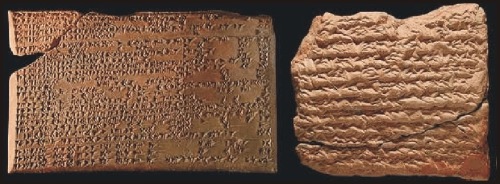Kvanvig: Transmission of Antediluvian Revelation
by Estéban Trujillo de Gutiérrez
“The apkallus provided the human race with the fundamental wisdom necessary to develop human civilization. They did so through their teaching, and according to Mesopotamian tradition, developed in the first millennium, they did so also through their writing activity.

A tablet containing parts of the Etana Myth.
British Museum, ME K 19530, AN 33047001.
http://www.britishmuseum.org/explore/highlights/highlight_objects/me/c/cuneiform_the_legend_of_etana.aspx
The apkallus are listed several places as authors of literary works in the Catalogue of Texts and Authors; colophons and other references to their authorship add to this list.
“Catalogue I, 5-7: Uanadapa is listed with an unknown work.
Catalogue III, 7: apkallu listed as author of compositions.
Catalogue IV, 11: third apkallu, Enmedugga, listed as author of several works.
Catalogue VI, 11: last apkallu in Bīt Mēseri, Lu-Nanna: Author of the Etana Myth.
Catalogue VI, 16: work which “Adapa wrote at his dictation.”
Colophon to medical text: “a secret of Lu-Nanna, apkallu of Ur.”
Colophon: “according to the old apkallus from before the flood.”
Verse Account of Nabonidus, col. v, 12: u sakar (SAR) d A-num d A-num d En.líl.lá ša ik-su-ru A-da-p[a]. The name of the series “which Adapa has compiled” appears to be an odd way to write the name of Enuma Anu Enlil.

Cylinder of Nabonidus, Temple of Shamash at Larsa. This terra-cotta cylinder records the renovations by king Nabonidus of the Temple of the Sun god Shamash at Larsa.
Neo-Babylonian Period, 555 BCE – 539 BCE.
Held at the British Museum, London.
https://commons.wikimedia.org/wiki/File:Cylinder_of_Nabonidus_from_the_temple_of_Shamash_at_Larsa,_Mesopotamia..JPG
Hellenistic text from Babylon: Uan listed as the author of an unknown literary work, most likely astronomical.
Hellenistic text from Babylon: Uan listed as author of unknown work.
Berossos: Oannes is the author of Enuma Elish.”
(Cf. Lambert, “A Catalogue,” pp. 59-77. Also see K. 8080, cf. W.G. Lambert, “Ancestors, Authors and Canonicity,” JCS 11, 1957, pp. 1-14, 1-4, 7, and K. 4023, Ibid., p. 8. Machinist and Tadmor, “Heavenly Wisdom,” pp. 146-8. CLBT AB 249, cf. J. Oelsner, Materialien zur babylonischen Gesellschaft und Kultur in hellenistischer Zeit, Budapest, 1986, 207f and 239. Cf. Streck, “Oannes,” p. 2.)
We see that among the apkallus Uan or Adapa is most often referred to as an author, which is also reflected by the prominent place this first sage has in Berossos.
According to the scribes of the Verse Account, Adapa was the compiler of the widely known and most authoritative astronomical series Enuma Anu Enlil. Berossos’ claim that Oannes should have written Enuma Elish may simply reflect his own literary composition, where Enuma Elish plays a major role as background for his record of creation.

Enuma Anu Enlil is a series of about 70 tablets dealing with Babylonian astrology. These accounts were found in the early 19th century by excavation in Nineveh, near present day Bagdad. The bulk of the work is a substantial collection of omens, estimated to number between 6500 and 7000, which interpret a wide variety of celestial and atmospheric phenomena in terms relevant to the king and state. The tablets presumably date back to about 650 BC, but several of the omens may be as old as 1646 BC. Many of the reports found on the tablets represent “astrometeorological” forecasts (Rasmussen 2010).
http://www.climate4you.com/ClimateAndHistory%205000-0%20BC.htm
In a few places in the Catalogue we get information about how a composition came into being. We find one notice connected to Kabti-ilāni-Marduk (III, 1-2). The Catalogue here first quotes the first line of the Poem of Erra, then comes a lacunae, followed by two verbs.
The two verbs correspond to the postscript about how the composition came into being in the Poem of Erra itself. Lambert therefore restores the passage according to the Poem of Erra.
“[annû ša Kabti-ilāni Marduk mār Dabibi] ušabrišuma idbubû.
[This is what] (the god) revealed to [Kabti-ilāni-Marduk, son of Dabibi] and which he recited.”
(Catalogue of Texts and Authors III, 2.)
We find the full report of how the revelation took place in the Poem of Erra:
“The compiler of his tablets was Kabti-ilāni-Marduk, son of Dabibi.
The god revealed it to him during the night time,
and when he in the morning slumber recited (it), he did not omit anything,
nor did he add a single line to it.”
(Poem of Erra V, 42-4.)
The signs preserved to the account of how Uanadapa composed his first work in the Catalogue making a restoration along the same line likely.
“[These are what] (the god) [revealed]
to Uanadapa and which he spoke.”
(Catalogue of Texts and Authors I, 6-7. Cf. Lambert, “A Catalogue,” p. 73.)
Thus, Uanadapa, like Kabti-ilāni-Marduk, was the second link in the chain of transmission; the composition was revealed to him by a god. The Š stem of barû, “see,” šubrû, is causative, “reveal,” and is often used with the meaning “reveal in a vision.”
Helge Kvanvig, Primeval History: Babylonian, Biblical, and Enochic: An Intertextual Reading, Brill, 2011, pp. 146-8.
